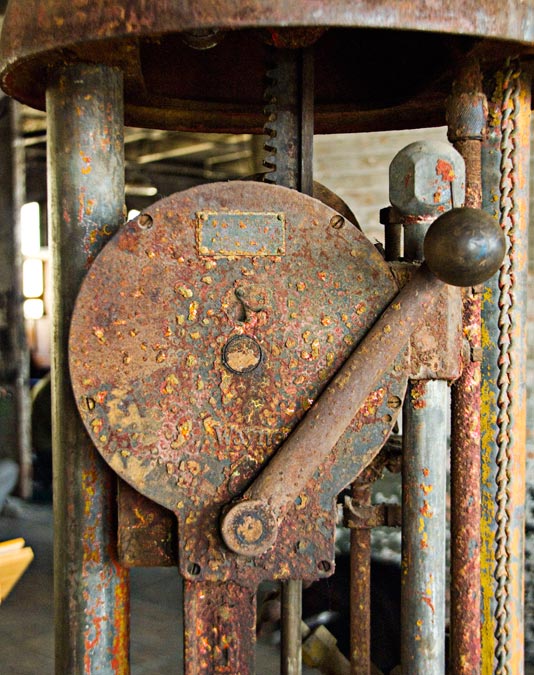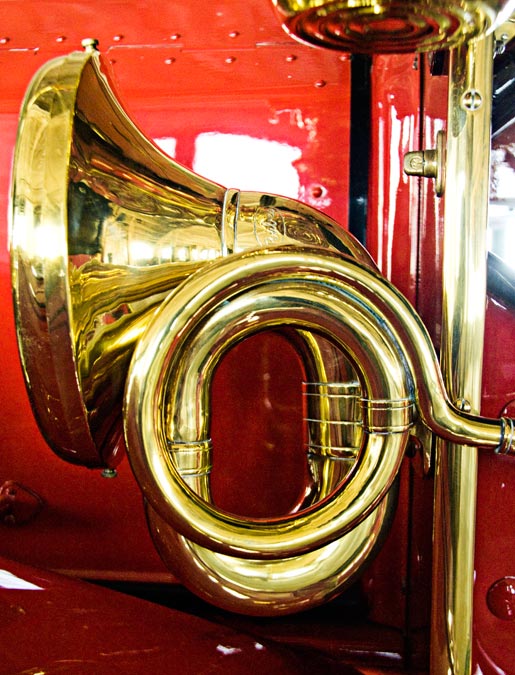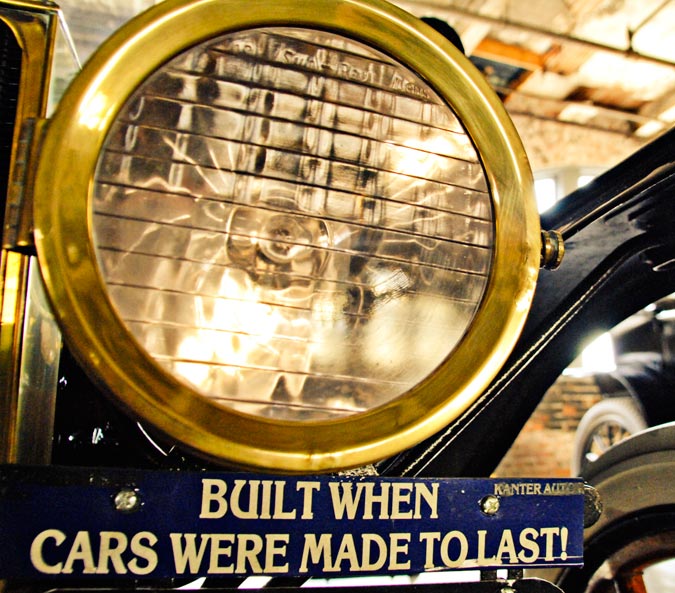Just north of the Ford Piquette factory is a spread of railroad tracks, once the nexus of two major lines - the Detroit & Milwaukee and Grand Trunk, which bridged much of the Midwest and Canada in an accord of industry, travel and expedience. When Henry Ford moved his tinker-y automotive operation there in 1904, the neighborhood - known as Milwaukee Junction - was pounding with other car makers, stamping plants, parts suppliers and fab shops. Home to Dodge, Packard, Regal and Cadillac, it was the nerve center of an emerging new Detroit - a Detroit built on internal combustion, efficient production, and innovative enterprise. But it was the Piquette Factory that sealed the city's fate: on September 27, 1908, the first Model T rolled off its assembly line. And from there, the Model T changed the world.
On one of those early spring days, when it's still too cold to ditch the jacket but some of us do anyway, we met Computer Perfection at the Piquette Factory. Brazenly, the shoot started out on the railroad tracks, as if to pay tribute to a mode of transportation that the automobile changed forever (the analogy isn't perfect; the tracks are now part of the Canadian National Railway, and we spent a lot of time during the first hour of the day looking behind us, feeling for rumblings).
Computer Perfection isn't normally an acoustic band, but for their Single Barrel shoot they unplugged, pared down, and dragged along a briefcase (and more) full of curiosities: a melodica, a recorder, a stylophone, some noise-making battery-operated animals, a cherry-red toy piano. And with singer Amy Bem in a red coat, a red floor tom and some cardinals in the trees, it wasn't looking good for the last gray grumbles of winter.
Milwaukee Junction is quiet these days, although some of the factories are still open and making things. The Piquette Factory is open, too; today it's the T-Plex, an educational automotive museum that showcases dozens of gleaming Model Ts and other vintage Fords. The space, nearly unchanged since 1910, is raw. The floors are original, the walls unpainted, and hundreds of handcrafted triple-frame windows flood the long halls with sunlight. It inspires reverence right away.
At the back of the factory is the "experimental room" where Henry Ford worked (with the developers and designers -- not with the executives on the first floor). A rocking chair in the corner evokes the image of Ford, the great concocter, the inventor and the visionary, swaying over blueprints, the noise and heat of the production floor just a thin wall away, smoking a pipe. The band sets up here, bass player (and, in this acoustic reimagining, acoustic rhythm guitar strummer) Steve McCauley settling into the mythical rocking chair, Nathaniel Burgundy supplying some strange sounds from his briefcase of tricks that push this otherwise sweetly poppy combo into weirder, blippier territory. The restless spirit of invention, it seems, lives on, and the warm, spacious music brings new life to the factory.
For a grand finale, all five members of Computer Perfection clamor into a Tin Lizzie and play a set perfect for Sunday driving out in God's great open spaces, just like Henry intended. Closing the song with a shocking AAAOOOOOHHGGAA from a still-working car horn, after so much easy, lilting melody, Computer Perfection, in one silly and smiling moment, marries Detroit's celebrated industrial heritage to what might be its most valuable new commodity: its creative production capacity.
- Amy Elliott
On one of those early spring days, when it's still too cold to ditch the jacket but some of us do anyway, we met Computer Perfection at the Piquette Factory. Brazenly, the shoot started out on the railroad tracks, as if to pay tribute to a mode of transportation that the automobile changed forever (the analogy isn't perfect; the tracks are now part of the Canadian National Railway, and we spent a lot of time during the first hour of the day looking behind us, feeling for rumblings).
Computer Perfection isn't normally an acoustic band, but for their Single Barrel shoot they unplugged, pared down, and dragged along a briefcase (and more) full of curiosities: a melodica, a recorder, a stylophone, some noise-making battery-operated animals, a cherry-red toy piano. And with singer Amy Bem in a red coat, a red floor tom and some cardinals in the trees, it wasn't looking good for the last gray grumbles of winter.
Milwaukee Junction is quiet these days, although some of the factories are still open and making things. The Piquette Factory is open, too; today it's the T-Plex, an educational automotive museum that showcases dozens of gleaming Model Ts and other vintage Fords. The space, nearly unchanged since 1910, is raw. The floors are original, the walls unpainted, and hundreds of handcrafted triple-frame windows flood the long halls with sunlight. It inspires reverence right away.
At the back of the factory is the "experimental room" where Henry Ford worked (with the developers and designers -- not with the executives on the first floor). A rocking chair in the corner evokes the image of Ford, the great concocter, the inventor and the visionary, swaying over blueprints, the noise and heat of the production floor just a thin wall away, smoking a pipe. The band sets up here, bass player (and, in this acoustic reimagining, acoustic rhythm guitar strummer) Steve McCauley settling into the mythical rocking chair, Nathaniel Burgundy supplying some strange sounds from his briefcase of tricks that push this otherwise sweetly poppy combo into weirder, blippier territory. The restless spirit of invention, it seems, lives on, and the warm, spacious music brings new life to the factory.
For a grand finale, all five members of Computer Perfection clamor into a Tin Lizzie and play a set perfect for Sunday driving out in God's great open spaces, just like Henry intended. Closing the song with a shocking AAAOOOOOHHGGAA from a still-working car horn, after so much easy, lilting melody, Computer Perfection, in one silly and smiling moment, marries Detroit's celebrated industrial heritage to what might be its most valuable new commodity: its creative production capacity.
- Amy Elliott
The Ford Piquette Avenue plant in Detroit may be the most significant auto-heritage site in the world. Built in 1904, the plant is the birthplace of the Model T. The New England mill-style structure is the first building built for Ford Motor Company. Here is where Henry Ford and his team built the first 12,000 Model Ts.
The plant is located in an area known as Milwaukee Junction, the emerging auto industry's central location after the turn of the last century. By the 1920's, Milwaukee Junction was Detroit's industrial heartbeat. The Model T Automotive Heritage Complex, Inc (T-Plex, for short) was established in April 2000 and remains today dedicated to the mission of preserving the birthplace of the Model T.
Nearly a dozen committees are involved in exhibits, loaning cars, newsletter and public relations, strategic long range planning, and window restoration, among others.
From www.tplex.org
The plant is located in an area known as Milwaukee Junction, the emerging auto industry's central location after the turn of the last century. By the 1920's, Milwaukee Junction was Detroit's industrial heartbeat. The Model T Automotive Heritage Complex, Inc (T-Plex, for short) was established in April 2000 and remains today dedicated to the mission of preserving the birthplace of the Model T.
Nearly a dozen committees are involved in exhibits, loaning cars, newsletter and public relations, strategic long range planning, and window restoration, among others.
From www.tplex.org





















Ivan I Know
[Download MP3]
Sans Soleil
[Download MP3]
Domestic Amusements
[Download MP3]
Silence Is A Shadow's Dream
[Download MP3]
How I Won The War
[Download MP3]
[Download MP3]
Sans Soleil
[Download MP3]
Domestic Amusements
[Download MP3]
Silence Is A Shadow's Dream
[Download MP3]
How I Won The War
[Download MP3]
DP
Sound
Edits
Stills
Words



